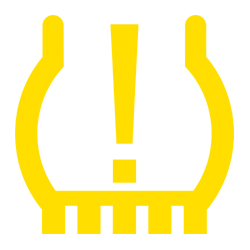
Do you know what the number one cause of tire wear is? Incorrect tire pressure. All tires require that the air pressure is consistent to obtain maximum performance and life.
Due to the seasonal changes throughout the year, you can expect your tire pressure to drop or increase. A temperature swing of about ten degrees will cause your pressure to drop or increase by one pound. Be sure to check the recommended air pressure in your owner’s manual. This information will increase tire life if followed.
A tire pressure monitoring system (TPMS) is an electronic system to monitor the air pressure inside a pneumatic tire. They are sometimes referred to as remote tire pressure monitoring systems (RTPMS) or simply as Run flat indicators. There are two types of TPMS and they are as follows:
Direct
Direct TPMS delivers real time tire pressure information to the driver of the vehicle – either via a gauge or a simple low pressure warning light. These systems employ physical pressure sensors inside each tire and a means of sending that information from inside the tire to the vehicle instrument cluster.
Indirect
Indirect TPMS measures the air pressure indirectly by monitoring individual wheel speeds and other signals available in the vehicle. Most indirect TPMS uses the fact that an under-inflated tire has a slightly smaller diameter than a correctly inflated tire and therefore has to rotate more times to cover a specific distance to detect under-inflation. Such TPMS can detect under-inflation in up to three tires simultaneously but not in all four since the operating principle of these systems is to compare the different wheel speeds and if all four tires lose the same amount of air the relative change will be zero. Newer developments of indirect TPMS can also detect simultaneous under-inflation in all four tires thanks to vibration analysis of individual wheels or analysis of load shift effects during acceleration and/or cornering. Indirect TPMS is cheap and easy to implement since most modern vehicles already have wheel speed sensors for anti-lock braking systems and electronic stability control systems. The disadvantage is that they rely on the user resetting the system by pushing a “Calibration Button” when the tires are changed or re-inflated – forgetting to perform this initialization leads to potentially dangerous false or missing alerts. Another disadvantage of indirect TPMS is that if the Calibration Reset Button is pressed when one or more tires are under-inflated then the system accepts this under-inflation as normal and the driver will be unaware of potentially dangerous tire pressures.





